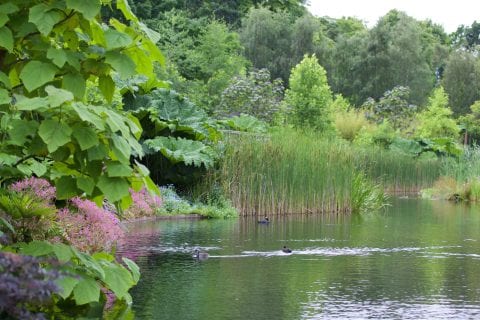Animals
Plant Life- Key Info
- Webcams
- Animal Encyclopedia
- Plant Life
Animals
Plant Life
Dublin Zoo is home to over 2,000 plant species that have been carefully planted around the grounds. From bamboo to the Irish oak, the plants are as important to the zoo as the animals. Plants are essential to nearly all life on earth and a healthy habitat has lots of different types of plants.
Not only do we want the animals to feel at home by adding plants from their natural habitats into their zoo home, we also want to make sure we are helping native Irish species thrive.
Plant Life
Dublin Zoo is home to over 2,000 plant species that have been carefully planted around the grounds. From bamboo to the Irish oak, the plants are as important to the zoo as the animals. Plants are essential to nearly all life on earth and a healthy habitat has lots of different types of plants.
Not only do we want the animals to feel at home by adding plants from their natural habitats into their zoo home, we also want to make sure we are helping native Irish species thrive.
Gunnera
This spectacular South American plant can grow two metres high and wide in a single spring season.
Gunneras have a unique relationship with micro-organisms called bluegreen algae. These algae enter the plant through glands at the base of its stem. The algae provide the plant with nitrogen in return for carbon.
This species comes from southeastern Brazil. Much smaller species are found in New Zealand, Central America and South Africa. Scientists believe the group first arose when the continents were joined together in a supercontinent known as Gondwanaland. Gunneras spread and evolved as the continents drifted apart.
Fun Fact
Gunnera leaves die back in winter to large resting buds. We cover these buds with the dead leaves to protect them from frost.
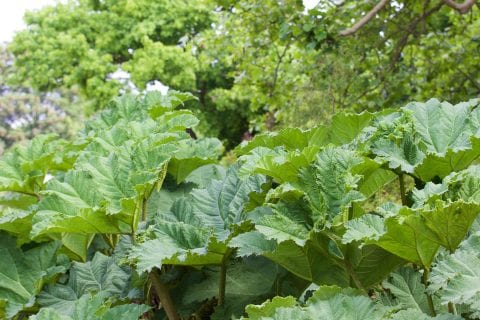
Bamboo
Bamboos are woody grasses that can grow up to 30 metres tall. They are the dominant plants of the Asian rainforest.
Bamboos grow astonishingly quickly- more than 25 centimetres a day in a hot climate. Even here in Dublin, the bamboo around you reaches its full height in a single, three-month growth spurt. The tall stems are hollow and very strong when fully grown.
All specimens of the same species burst into flower at the same time, no matter where in the world they are growing. We do not yet know what triggers this mass flowering event.
Fun Fact
Bamboos can spread very rapidly, so watch out for escaping runners if you plant them in your garden!
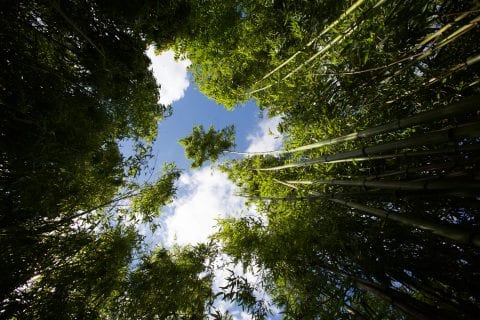
Deodar
This magnificent tree is nearly as old as the zoo. It was planted around 1850, when it was the fashion to grow new and exotic trees.
The deodar is a type of cedar that grows wild in the western Himalayas. It is the national tree of Pakistan and is also sacred to Hindus. The name comes from the Sanskrit words ‘deva’ (god) and ‘daru’ (wood).
Chemical compounds in deodar wood make it rot resistant and insect proof. It is often used to build temples, public buildings and house boats. The aromatic wood repels insects, so it is also used in the storage of meat and grain stores, and on hangers to ward off clothes moths.
Fun Fact
Oil distilled from the wood is used as incense and also repels insects.
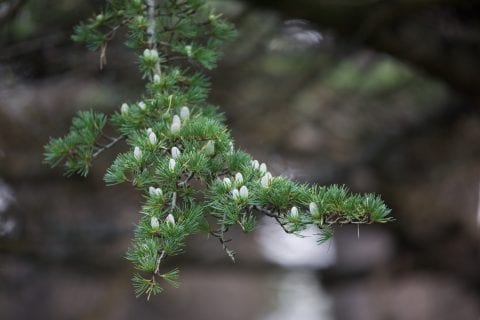
Wollemi Pine
This is a ‘living fossil’, the only surviving member of a group of plants that date back to the age of dinosaurs.
In 1994, David Noble, an Australian National Park ranger in the Blue Mountains, discovered some unusual trees – so unusual, they were previously known only from fossils. Only 100 survive in the wild today and they are under threat from a fungal disease, but they grow well in parks and gardens. A percentage of the price of each nursery plant sold goes to support conservation projects.
Fun Fact
The wollemi pine is not a true pine. It is related to the monkey puzzle tree, an ancient family of conifers.
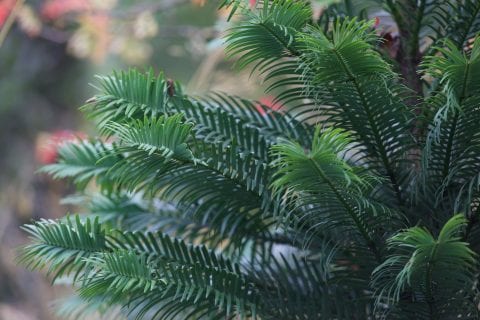
Grasses and Grazers
Grasses and grazers have evolved together, shaping the savanna ecosystem we see today.
Much of Africa dried out 10 to 4 million years ago and forests gave way to open grasslands.
Grasses thrived in the dry and sunny conditions. Large grazing herbivores quickly evolved to take advantage of this new habitat, soon followed by predatory carnivores.
The pressure of their intense grazing led to changes. New grass species evolved with silica in their leaves. This made them harder to chew. The herbivores, in turn, evolved stronger grinding teeth to cope.
Fun Fact
Zebras have long, wear-resistant teeth to crop the tough grass, and large stomachs to store and slowly digest it.
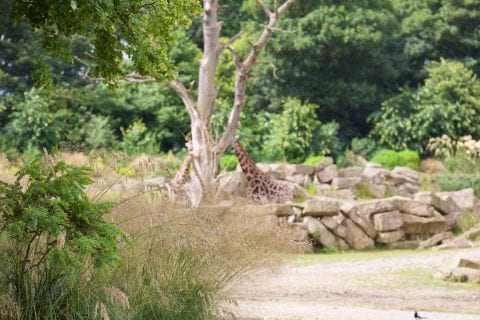
Boreal Forest
Nearly a third of all the forest cover on earth lies south of the Arctic circle, stretching in a great band across Russia, Europe and North America.
In boreal forests, the dominant trees are conifers. They have evolved to cope with cold and dry conditions. Their thin, needle-like leaves reduce water loss and their drooping branches shed snow.
Conifers keep their leaves all year, ready to work whenever the sun is strong enough. In the far north, the growing season is very short and trees only put on a few weeks’ growth each year. Here, in Ireland’s mild and moist climate, they grow very well.
Fun Fact
Conifers are record breakers. One of the oldest plants on Earth is a 5000-year-old bristlecone pine and the tallest tree is a coastal redwood. At 115 metres, it is as tall as the Dublin spire
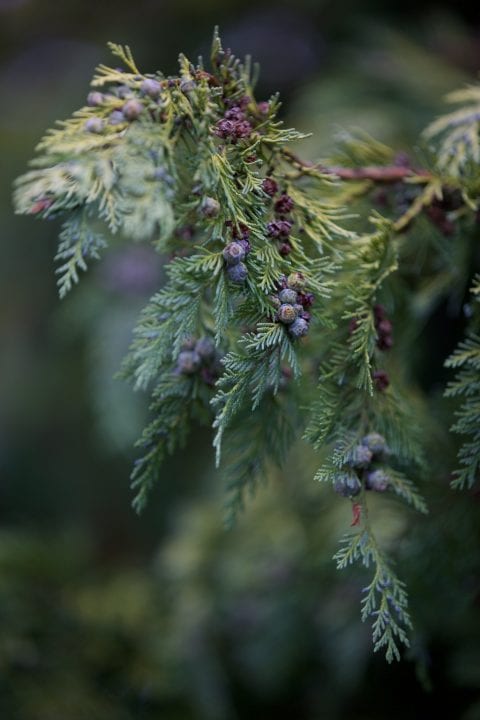
Gorilla Rainforest
Our habitat is inspired by the watery clearings or ‘bais’, where gorillas gather to feed in the Congolese rainforest.
We have planted a dense mix of trees, shrubs, grasses and water plants for the gorillas to explore. Searching for food among the vegetation is an important natural behaviour.
Our gorillas are learning what they can and cannot eat. We have included some plants that produce bitter chemicals as a defense against damage by insects and foraging primates.
Fun Fact
Gorillas enjoy grasses, clover, dandelions, berries and flowers but avoid bitter plants.
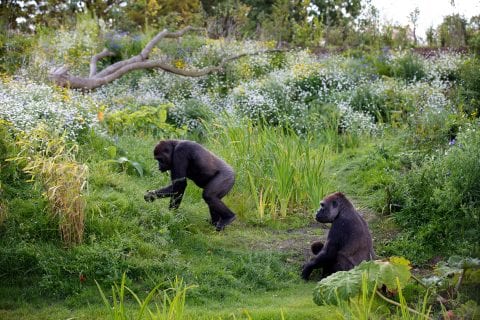
African Savanna
We design our planting very carefully to create habitats that reflect the wild habitats of our animals.
Grasses dominate the savanna landscape. They can resist long periods of drought and grow quickly when the rain comes. Great migrating herds of herbivores follow the rain to feed off this new growth.
Grasses support even more life underground than above it. Their roots form a dense mass in the soil, helping to reduce soil erosion in heavy rain and storing food to regrow after drought. These roots are home – and food – to a vast number of invertebrates.
Fun Fact
Grasses are especially tough and tolerant of grazing. They grow from soil level, so any leaves grazed off can be replaced easily.
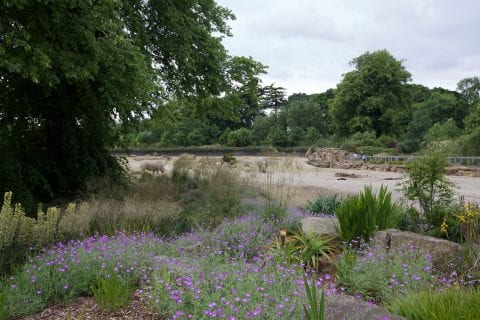
Lake Edges
Grasses and grazers have evolved together, shaping the savanna ecosystem we see today.
Much of Africa dried out 10 to 4 million years ago and forests gave way to open grasslands. Grasses thrived in the dry and sunny conditions. Large grazing herbivores quickly evolved to take advantage of this new habitat, soon followed by predatory carnivores.
The pressure of their intense grazing led to changes. New grass species evolved with silica in their leaves. This made them harder to chew. The herbivores, in turn, evolved stronger grinding teeth to cope.
Fun Fact
Plants will always try to reclaim water if they can, spreading slowly from the edges. Swans now nest among our iris.
